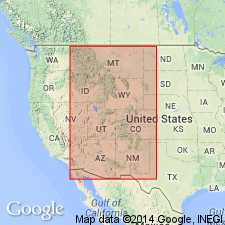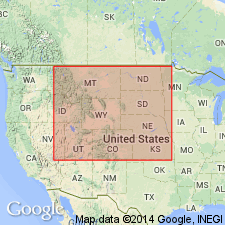
- Usage in publication:
-
- Chadronian age
- Modifications:
-
- Original reference
- AAPG geologic province:
-
- Chadron arch
Summary:
Pg. 11, pl. 1. Chadronian age. Provincial time term, based on the Chadron formation, type locality near Chadron, Nebraska. Includes the old term "TITANOTHERIUM beds," used in its more extended sense. Covers the interval between the Duchesnean (Eocene) and Orellan (Oligocene) ages. [In lower part of Oligocene; = BRONTOTHERIUM faunal zone.] Report defines 18 provincial time terms, based on mammal-bearing units, for the North American continental Tertiary. [For sequence see under Puercan.]
Source: US geologic names lexicon (USGS Bull. 1200, p. 703-704).

- Usage in publication:
-
- Chadronian North American Land Mammal "Age"
- Modifications:
-
- Age modified
- Geochronologic dating
- AAPG geologic province:
-
- North America
Summary:
40Ar/39Ar dates on biotite from the "Purple White Layer" (PWL) yielded a mean age of 33.91 +/-0.06 Ma (latest Eocene). PWL is an ash that marks boundary between Chadron Formation and overlying Orella Member of Brule Formation and marks the Chadronian-Orellan North American Land Mammal "Age" boundary and the Eocene-Oligocene boundary. Thus, the Chadronian and Chadron are now latest Eocene age and the Orellan and lower part of Brule are earliest Oligocene age. Ash samples taken from Flagstaff Rim section, Natrona Co, south-central WY, Wind River basin. In the Vieja sequence of west TX, dates from the Bracks Rhyolite and Buckshot Ignimbrite are used to calibrate the Duchesnean-Chadronian transition. 40Ar/39Ar dates on sanidine yielded ages of 36.67 +/-0.04 Ma for Bracks and 37.8 +/-0.06 Ma for the underlying Buckshot. Tables of isotopic dates.
Source: GNU records (USGS DDS-6; Denver GNULEX).
For more information, please contact Nancy Stamm, Geologic Names Committee Secretary.
Asterisk (*) indicates published by U.S. Geological Survey authors.
"No current usage" (†) implies that a name has been abandoned or has fallen into disuse. Former usage and, if known, replacement name given in parentheses ( ).
Slash (/) indicates name conflicts with nomenclatural guidelines (CSN, 1933; ACSN, 1961, 1970; NACSN, 1983, 2005, 2021). May be explained within brackets ([ ]).

